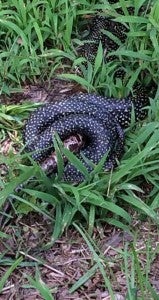Not every snake is a “bad” snake
Published 3:15 pm Wednesday, June 11, 2014
n the back yard of a JDC resident where grandchildren were at play a particular movement caught the eye of the grandfather.
Writhing in the fallen leaves that would have been totally camouflaged without the movement was a snake, and being a cautious grandparent he immediately retrieved a hoe and dispatched the intruder.
However, on closer inspection he realized there were two snakes and the motion he observed was caused by a life and death struggle.
A King snake had a Cottonmouth moccasin in the grips of his coils and was slowly strangling it to death. He commented that had he realized what was happening he would not so hastily dispatched the two because the non-venomous King was actually protecting his precious grands from the undetected venomous Cottonmouth.
Wikipedia reports that about a third of adult humans are ophidiophobic, (abnormally afraid of snakes) making it the most common reported phobia but the philosophy that the “only good snake is a dead snake” may be putting us more at risk than we know.
Eliminating all snakes in an area until none are left can makes a crack the cycle of nature causing a boom in unwanted other pests such as mice and rats and eliminating a non-venomous “useful” snake such as the King Snake that preys on the venomous of the species can cause an overload in the population of the potentially dangerous to human snakes increasing the risks of a deadly encounter.
If you are not one of the ophidiophobics and can stand the sight of the gliding serpents close to your home and garden there are many good reasons to keep them around.
In some grain raising countries biologists are reintroducing rat-eating snakes to protect the harvests.
In the United States, biologists are trying to get the word out about the good points of the scaly slitherers in order to protect these important predators. A single black snake, for instance, can eat dozens of rats a year and small snakes, such as green snakes, garter snakes, and ring-necked snakes, hunt insects some even specializing in daddy long-legs!
Become “snake-aware” and learn the venomous from the non-venomous but it is always the best to err on the side of caution and give all snakes plenty of space, however, refraining from killing every one you see could make your yard and garden a little safer.





